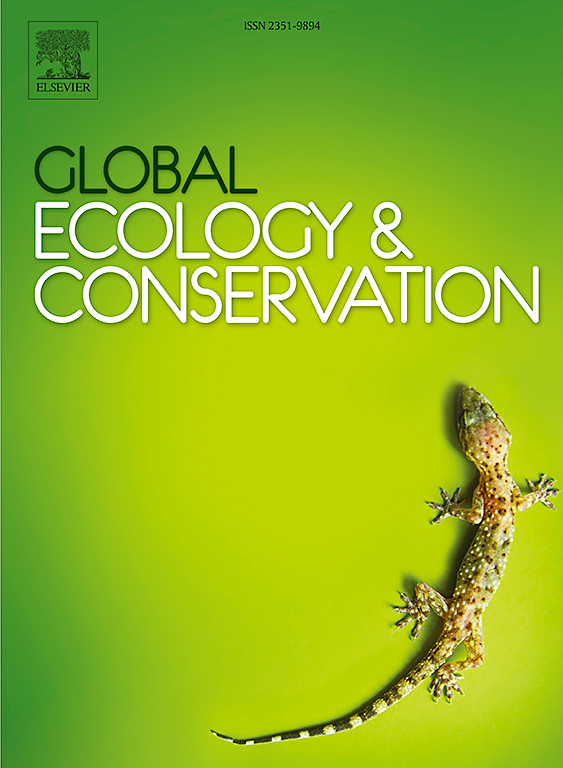在韩国温带森林中,生态系统服务和多功能性是由生物和非生物因素以及森林类型共同调节的
IF 3.4
2区 环境科学与生态学
Q1 BIODIVERSITY CONSERVATION
引用次数: 0
摘要
考虑到大规模森林砍伐和日益严重的栖息地丧失等全球性问题,促进森林生态系统的多功能性(EMF)对于成功实施全球可持续发展至关重要。本研究旨在基于18个生态系统服务相关变量,量化四种生态系统服务类别(即供给、调节、文化和支持)及其综合提供能力。此外,我们还评估了生物(即物种多样性、功能优势、林分结构多样性)和非生物(即地形、气候和土壤)因素以及林龄对EMF和各生态系统服务类别的影响。在韩国温带代表性森林加里王山的7种主要森林类型中,共收集了98个样地的数据,每个样地20 × 20 m。使用多模型平均和分段结构方程建模来确定影响EMF和生态系统服务类别的关键变量,并评估它们之间的相互关系。研究结果表明,较高的植物物种丰富度和较老的林分增加了林分结构多样性,直接且正向地影响了林分结构多样性。EMF主要由生物因素驱动,如群落加权平均特征,而不是非生物因素。影响各生态系统服务功能的机制不同。方差划分分析表明,4种生态系统服务类型对生态系统EMF的相对贡献相似,支持和调节服务类型对生态系统EMF分别表现出显著的负向和正向影响。这些结果表明,森林管理应综合考虑林龄和结构多样性,以提高森林生态系统服务类型和生态系统服务类型。此外,促进木材密度和叶片氮含量等功能性状的管理措施对于增加EMF至关重要。最后,生态系统服务类别对EMF的控制程度因森林类型而异,因此必须为每种森林类型制定明确的管理计划。本文章由计算机程序翻译,如有差异,请以英文原文为准。
Ecosystem services and multifunctionality are co-regulated by biotic and abiotic factors along with forest types in a temperate forest of South Korea
Given global issues such as large-scale deforestation and increasing habitat loss, promoting forest ecosystem multifunctionality (EMF) is essential for the successful implementation of global sustainable development. This study aims to quantify the four ecosystem service categories (i.e., provisioning, regulating, cultural, and supporting) and the ability to comprehensively provide them, EMF, based on 18 ecosystem services-related variables. Additionally, we evaluated the influence of biotic (i.e., species diversity, functional dominance, stand structural diversity) and abiotic (i.e., topography, climate, and soil) factors, and stand age on EMF and each ecosystem service category. We collected data from 98 plots, each 20 × 20 m, across the seven major forest types of Mt. Gariwang, which is a representative temperate forest in South Korea. Multimodel averaging and piecewise structural equation modeling were used to identify key variables influencing EMF and ecosystem service categories and to assess their interrelationships. Our results show that higher plant species richness and older forest stands enhanced stand structural diversity, which directly and positively affected EMF. EMF is primarily driven by biotic factors, such as the community weighted mean of traits, rather than abiotic factors. The mechanisms influencing each ecosystem services differed. Variance partitioning analysis revealed that the relative contributions of the four ecosystem service categories to the EMF are similar, with supporting and regulating services categories showing significant negative and positive effects on EMF, respectively. These findings suggest that forest management should comprehensively consider stand age and structural diversity to enhance EMF and as well as individual ecosystem service category. Furthermore, management practices that promote functional traits, such as wood density and leaf nitrogen content, are essential for increasing EMF. Finally, the degree of control of ecosystem service categories over EMF varies across forest types, so a clear management plan must be developed for each forest type.
求助全文
通过发布文献求助,成功后即可免费获取论文全文。
去求助
来源期刊

Global Ecology and Conservation
Agricultural and Biological Sciences-Ecology, Evolution, Behavior and Systematics
CiteScore
8.10
自引率
5.00%
发文量
346
审稿时长
83 days
期刊介绍:
Global Ecology and Conservation is a peer-reviewed, open-access journal covering all sub-disciplines of ecological and conservation science: from theory to practice, from molecules to ecosystems, from regional to global. The fields covered include: organismal, population, community, and ecosystem ecology; physiological, evolutionary, and behavioral ecology; and conservation science.
 求助内容:
求助内容: 应助结果提醒方式:
应助结果提醒方式:


